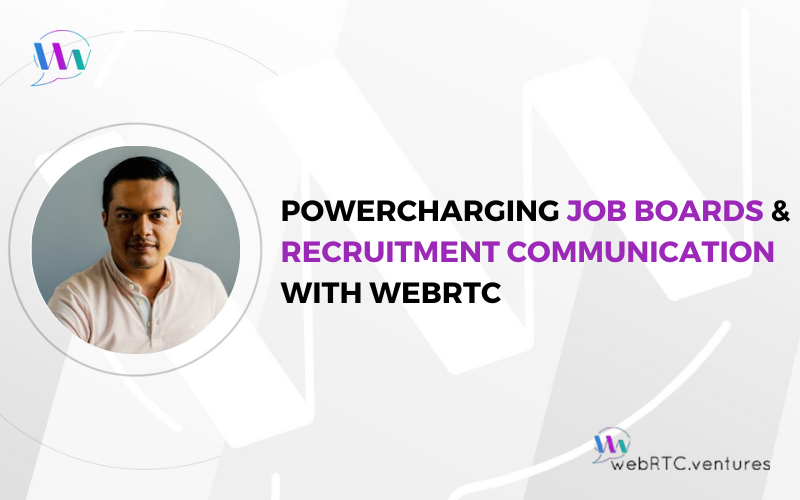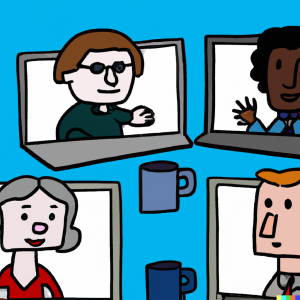A job board acts as the matchmaking app of the career world, where companies and candidates swipe right on their ideal professional connections. Organizations want to select the most qualified candidates to join their workforce. Candidates want to know more about the company and the open role, in order to decide if it’s the best place for them to work.
Recruitment, starting from an external job board and continuing through the interview and selection process, is a critical task. Effective communication through efficient tools is the key to making the best decisions for both parties. WebRTC can provide centralized real-time communication capabilities that help job boards and recruitment platforms to reach this goal.
In this post, we will delve into the challenges that get in the way of good communication on job boards and in recruitment in general. Then, we will explore how WebRTC can powercharge the process.
The Challenges of Communication on Job Boards
Companies want to attract the best talent available and efficiently gather all the information needed to make an informed, data-driven, decision on who to hire. Candidates, on the other hand, want to work for a stable company that provides good pay and benefits, a welcoming culture, and the opportunity to develop professionally. In this context, communication between candidates and recruiters plays a crucial role in aligning both expectations.
However, common problems get in the way such as long screening processes, scheduling issues, and lack of visibility coming from overwhelmed recruiters who are not able to properly follow up due to their work volume. These add up to a subpar experience that causes qualified candidates to exit the process prematurely.
To make matters worse, the multiple channels that are often used for communication make the process difficult to keep up with. It’s hard to follow a conversation that started through a LinkedIn private message and then moved to a long email thread. And even harder to feed data and metrics from information scattered across three or more different places! Candidates are often forced to input the same information multiple times in different systems, significantly impacting the quality of their experience.
Thanks to tools like video conferencing and online skills and knowledge assessments, companies can reach talent that’s beyond their traditional territorial boundaries. However, these tools can require installing additional software, creating extra accounts in third-party services, and sharing personal contact information that can be later used for malicious purposes. This also means more data scattered around that needs to be processed.
What is WebRTC?
WebRTC is both an open standard and a technology that provides web browsers and native applications with the ability to securely exchange audio, video and any kind of data in real-time, through a peer-to-peer connection.
WebRTC enables this communication by providing open APIs that allow developers to build applications that can access computers and mobile device cameras, microphones and screens, and send such streams of data over the internet.
How Can WebRTC Help Your Job Board or Recruitment Platform?
Integrating WebRTC into job boards and recruiting practices can provide these benefits and more:
- Real-time video/audio/data communication capabilities enable features such as virtual interviews and chat right into the job board.
- In conjunction with other APIs such as the MediaStream Recording API, WebRTC enables recording audio and video interactions for future processing.
- By combining recordings with analysis tools powered by artificial intelligence (AI), companies can get the benefits of data-driven recruitment without the hassle of collecting and processing data manually.
Having all this functionality bundled within the job board enables companies to have full control over candidates’ experience and build a strong employer brand on top of it. Additional benefits include:
- There is no longer need to exchange personal information such as phone numbers or email addresses as part of the recruitment process. All the communication happens within the board itself.
- The conversation is much easier to follow!
- Having all the information in a single place allows the outcomes from each phase to automatically feed other parts of the process. For example, the results from an integrated AI tool that analyzed the recording of an interview can be used to generate screening reports.
This adds up to a level of automation that makes the overall process more efficient and allows recruiters to focus more on selecting the right candidates and less on repetitive tasks.
Sample Features Enabled by WebRTC on Job Boards
Let’s take a look at four examples of features that you can enable in your job board using WebRTC.
- Custom, Tailored Virtual Interviews
We already mentioned WebRTC enabling virtual interviews, but it doesn’t have to stop there. Contrary to using general purpose video conferencing tools, by building a custom one you can add any specific feature the process requires on top of it.
For instance, does your recruitment process include skill or knowledge assessments? These can be included as part of the virtual interview tools. The results can go straight to a dashboard or a scheduled report within the platform.
- Pre-Interview Screening
Video interviews are of course a great way to evaluate candidates without needing to be in the same geographical location. However, it is a time consuming task that involves selecting candidates, connecting with them, scheduling, interviewing and evaluating.
Wouldn’t it be great to evaluate candidates in an interview-like context, but without actually having to schedule an interview with them? Candidates can record themselves right in your platform answering custom questions, which you can review on your own schedule and screen out candidates that don’t match for a specific role early in the process.
- Preparation Tools for Candidates
Candidates can benefit from WebRTC-powered features too. Similar to the implementation of pre-interview screening mentioned before, a function that allows candidates to prepare for interviews can be built upon recording capabilities. We already see this in platforms such as LinkedIn, which offers an Interview Preparation Tool that allows candidates to record themselves answering common interview questions and getting immediate feedback using AI.
- AI-powered Processing
So far, most of the functionality we’ve discussed is targeted at gathering information about candidates. How can we make processing that information more efficient, reducing the burden for recruiters to manually go through the data?
To aid with this important task, job boards can integrate with Conversational AI services such as those offered by Symbl.ai. Conversational AI can perform sentiment analysis on the interview and candidates recordings to measure their experience, generate interview summaries, highlight specific keywords, and produce action items.
Take Your Job Board to the Next Level
WebRTC is a powerful tool for a job board as it empowers the communication features that help companies hire the right candidates efficiently, and also for candidates to find the right match themselves.
Having a centralized communication channel can help recruiters to build an effective communication process, gather metrics that allow making data-driven decisions, and provide candidates with visibility over each step of their job application process.
All in a secure, single platform with no need for external tools!
If you’re looking to take the experience of the candidates and recruiters in your job board to the next level, WebRTC.ventures has the expertise you need! Contact us today and let’s make it live!















